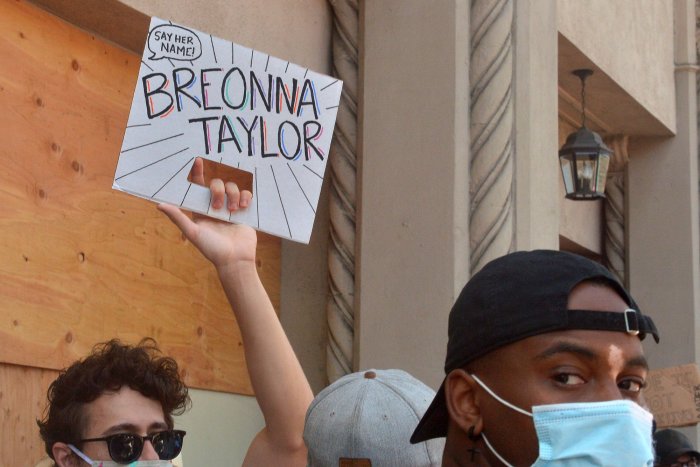Protesters march through downtown Minneapolis as jury deliberations begin in the Derek Chauvin trial in Minneapolis on Monday over the death of George Floyd. Photo by Jemal Countess/UPI |
License Photo
America's police are under assault. Following a litany of police shootings of African Americans and the death last year of George Floyd at the knee of Derek Chauvin, whose trial is about to end, demands and protests calling for "defunding," "reforming" and "demilitarizing" police have been deafening and ubiquitous.
Do these incidents reflect systemic and institutional flaws and failures inherent in policing and the nearly 18,000 police forces nationwide and 700,000 full-time officers? Or are other factors at work?
Regardless of these answers, American police forces have a lot to learn from the U.S. military in three areas: training, rules of engagement and ongoing education programs.
In terms of global rankings, the training and educating of American police are quite low. On average, American police officers undergo between 20 and 27 weeks of training followed by a period of probation lasting several months. In Germany, for example, police training lasts 2 1/2 to four years. U.S. Capitol Police, by contrast, undergo 27 weeks.
A careful and thoughtful analysis of police training is essential. The military has undergone massive investigations and revisions of training service personnel. During the Korean War, a surprising number of American prisoners of war collaborated with the enemy. As a result, a code of conduct was created and implanted in the military culture.
During the early years of the Vietnam War, Navy pilots were outfought by North Vietnamese fliers. The famous Top Gun Fighter Weapons School was established. As a result, the ratio of U.S. and North Vietnamese air kills reversed to about 15 to 1 in America's favor.
While Top Gun may not have direct application to police, training must be aligned with current conditions of society, culture, law enforcement and public attitudes. Standardization is also essential. And perhaps a federal law may be needed to codify training requirements, especially to ensure police undergo rigorous and ongoing preparation for stressful circumstances. Frequents war games and exercises make uniform personnel ready for conflict and high-risk situations.
Second, roles of engagement are central to military operations. Dating back to Vietnam, memorizing rules of engagement was mandatory. That did not prevent atrocities such as My Lai. However, in Afghanistan and Iraq, rules of engagement protected and guided American forces so that excessive caution would not result with the service member being carried to a final resting place by six good men and women, or that excessive aggression would not lead to judgment of 12 peers in a court-martial.
Clearly states, cities and local police forces need flexibility in setting rules of engagement, especially regarding the use of deadly force. And a national clearinghouse to oversee and coordinate rules of engagement across the nation to oversee compliance with the law must be put in place. Further, rules of engagement must be coordinated with the public sector and the many civilian groups and institutions with direct interests in policing, as well as to educate Americans on these vital matters.
Finally, long-term training and education programs must be mandatory to ensure police forces keep pace with changing trends, technology, public attitudes and the law. Policing today must deal with more than enforcing the law. Public safety and security rank as high or even higher priorities. Lessons from how the military carried out its duties in high threat conditions in which the enemy wore no uniforms and was often indistinguishable from civilians are very relevant.
As military personnel have assumed more technically challenged responsibilities from cyber, psychological operations, humanitarian tasks and even governing or administering villages and population centers, a similar transition for police is self-evident. This does not mean police must become more military like. Unfortunately, as drug gangs often outgunned police, police forces were militarized.
Indeed, a police SWAT team in full battle gear is difficult to distinguish from SEAL Team 6 or DELTA Force. But the training, rules of engagement and other lessons from the military are applicable to police without turning these forces into soldiers and Marines.
Given the political ramifications of the use of force by the police, whether appropriate, justified or not, and magnified by social media and the constant presence of cellphone cameras, the time has long past for a fundamental review of training of police and the rules that determine how policing is to be accomplished and guidance provided when officers are in harm's way or engaged in high-risk and tension-filled situations.
The penalties for deferring or ducking this responsibility are too great for even a minute's worth of deferral.
Harlan Ullman is senior adviser at Washington, D.C.'s Atlantic Council and author of the upcoming book, "The Fifth Horseman and the New MAD: The Tragic History of How Massive Attacks of Disruption Are Endangering, Infecting, Engulfing and Disuniting a 51% Nation."
The views and opinions expressed in this commentary are solely those of the author.
Demonstrators hold a sign in Los Angeles on June 14 for Breonna Taylor, a black woman who was shot by police in her home while she was sleeping. Photo by Jim Ruymen/UPI |
License Photo
















